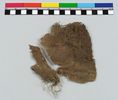
All the textiles illustrated on this page are in 'tabby weave' (1-over-1) or a variation of it.
Neolithic Period
 |
Fragments of cloth from a Neolithic settlement in the Fayum (UC 72770, about 5000 BC). This is one of the earliest surviving textile fragments from the Nile Valley: it has about 12 by 9 threads per cm (click here for detail). |
Early Dynastic Period
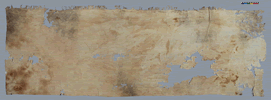 |
Garment from First Dynasty burial at Tarkhan (UC 28670, about 3000 BC). This has the typical 'warp-faced' character of dynastic Egyptian linen, with about 24 by 15 threads per cm (click here for detail). |
New Kingdom
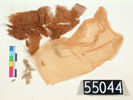 |
Fragment from the wrappings of the mummy of king Thutmose II (1492-1479 BC) (UC 55044): it is possible that the linen dates to the time of reburial at Deir el-Bahari, in the Third Intermediate Period, about 950 BC). This linen fabric is exceptionally fine, and has a relatively open weave (about 38 by 35 threads per cm - click here for a detail). |
Roman Period
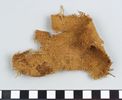 |
Detached fragment from cartonnage mummy casing (UC 28084): click on the image for a larger picture. This is relatively closely dateable to the mid-first century AD by the style of the hairstyle and jewellery depicted on the cartonnage casing from which it comes (image at right). |  |
The 'basket weave' with paired threads is typical of the Roman Period (in Egypt 30 BC to AD 395).
Changes in linen weaving in the late Roman Period
From the third century AD on, textiles still mainly of plain linen were often decorated with areas of tapestry weave combining linen with coloured threads, either of wool or, increasingly, silk. In the later Middle Ages, Egypt was still famous for its fine linen textiles.
Late Roman Period
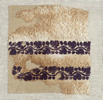 |
Fragment with tapestry bands in linen and dyed wool, within a ground of linen with weft loops (UC 75907, unprovenanced, fourth century AD): click on the image for a larger picture. |
Islamic Period
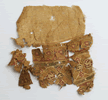 |
Fragment of tapestry in linen and coloured silk sewn to a plain linen textile (UC 25302, unprovenanced, late 11th or early 12th century AD): click on the image for a larger picture. |
Copyright © 2003 University College London. All rights reserved.